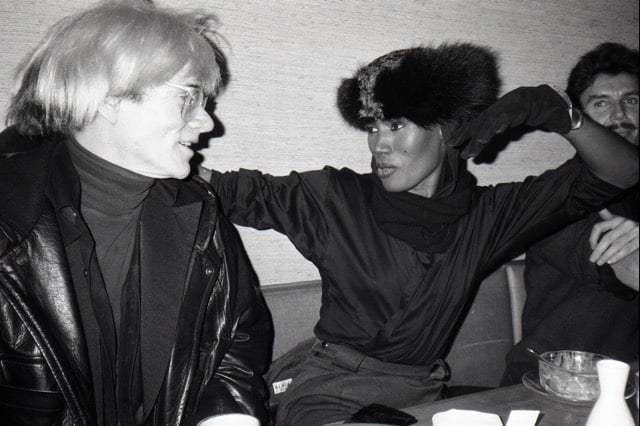I don’t know what is going on, but in the past few days, several sites have linked to rarely seen or recently uncovered photos of vintage New York. In no particular order:
Paige Powell’s photos of 80s culture in NYC, stored in boxes under her bed until very recently. She dated Basquiat and hung with Haring, Warhol, and Madonna. Below, Warhol and Grace Jones chat. Click through…there’s another photo of Sting, Bob Dylan, and Warhol having dinner together.

David Attie’s photographs of Brooklyn Heights from 1958, stored in wooden boxes in closets until recently. Attie was accompanied on his journey through the neighborhood by Truman Capote, a resident of the area. The photos are featured in a new edition of Capote’s Brooklyn: A Personal Memoir.

Charles Traub’s street style photos from the late 70s. He took the photos during his lunch breaks of everyday people he thought were interesting in some way. Traub’s photos are collected in a new book, Lunchtime.

Janet Delaney’s photos of NYC in the mid-80s. These photos have also been stored in a box until recently. Delaney also took dozens of photographs of SoMa in SF from 1978-1986.

One of my favorite magazine pieces is Truman Capote’s long profile of Marlon Brando from the Nov 9, 1957 issue of the New Yorker.
He hung up, and said, “Nice guy. He wants to be a director-eventually. I was saying something, though. We were talking about friends. Do you know how I make a friend?” He leaned a little toward me, as though he had an amusing secret to impart. “I go about it very gently. I circle around and around. I circle. Then, gradually, I come nearer. Then I reach out and touch them — ah, so gently…” His fingers stretched forward like insect feelers and grazed my arm. “Then,” he said, one eye half shut, the other, à la Rasputin, mesmerically wide and shining, “I draw back. Wait awhile. Make them wonder. At just the right moment, I move in again. Touch them. Circle.” Now his hand, broad and blunt-fingered, travelled in a rotating pattern, as though it held a rope with which he was binding an invisible presence. “They don’t know what’s happening. Before they realize it, they’re all entangled, involved. I have them. And suddenly, sometimes, I’m all they have. A lot of them, you see, are people who don’t fit anywhere; they’re not accepted, they’ve been hurt, crippled one way or another. But I want to help them, and they can focus on me; I’m the duke. Sort of the duke of my domain.”
In a piece for Columbia Journalism Review, Douglas McCollam details how Capote got access to the reclusive star when he was filming Sayonara in Japan.
Logan had no intention of subjecting his own cast and crew to the same withering scrutiny. In particular, he was concerned about what might happen if Capote gained access to his mercurial leading man. Though Brando was notoriously press-shy, and Logan doubted Capote’s ability to crack the star’s enigmatic exterior, he wasn’t taking any chances. He and William Goetz, Sayonara’s producer, had both written to The New Yorker stating that they would not cooperate for the piece and, furthermore, that if Capote did journey to Japan he would be barred from the set. Nevertheless, Capote had come.
As Logan later recounted, his reaction to Capote’s sudden appearance was visceral. He came up behind Capote, and without saying a word, picked the writer up and transported him across the lobby, depositing him outside the front door of the hotel. “Now come on, Josh!” Capote cried. “I’m not going to write anything bad.”
Logan went immediately upstairs to Brando’s room to deliver a warning: “Don’t let yourself be left alone with Truman. He’s after you.” His warning would go unheeded. Recalling his reaction to Capote, Logan later wrote, “I had a sickening feeling that what little Truman wanted, little Truman would get.”
Alexis Madrigal wrote about Capote’s Brando piece for the first installment of Nieman Storyboard’s Why’s This So Good series about classic pieces of narrative nonfiction.









Stay Connected